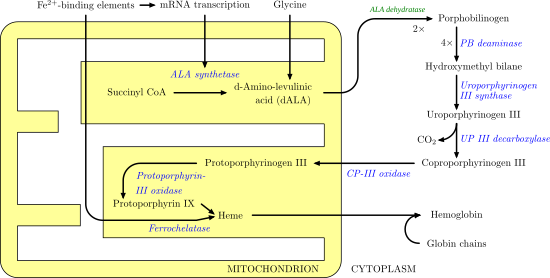Clinical significance
Hereditary coproporphyria (HCP) and harderoporphyria are two phenotypically separate disorders that concern partial deficiency of CPOX. Neurovisceral symptomatology predominates in HCP. Additionally, it may be associated with abdominal pain and/or skin photosensitivity. Hyper-excretion of coproporphyrin III in urine and faeces has been recorded in biochemical tests. [15] HCP is an autosomal dominant inherited disorder, whereas harderoporphyria is a rare erythropoietic variant form of HCP and is inherited in an autosomal recessive fashion. Clinically, it is characterized by neonatal haemolytic anaemia. Sometimes, the presence of skin lesions with marked faecal excretion of harderoporphyrin is also described in harderoporphyric patients. [16]
To date, over 50 CPOX mutations causing HCP have been described. [17] Most of these mutations result in substitution of amino acid residues within the structural framework of CPOX. [18] At least 32 of these mutations are considered to be disease-causing mutations. [19] In terms of the molecular basis of HCP and harderoporphyria, mutations of CPOX in patients with harderoporphyria were demonstrated in the region of exon 6, where mutations in those with HCP were also identified. [20] As only patients with mutation in this region (K404E) would develop harderoporphyria, this mutation led to diminishment of the second step of the decarboxylation reaction during the conversion of coproporphyrinogen to protoporphyrinogen, implying that the active site of the enzyme involved in the second step of decarboxylation is located in exon 6. [17]
This page is based on this
Wikipedia article Text is available under the
CC BY-SA 4.0 license; additional terms may apply.
Images, videos and audio are available under their respective licenses.






